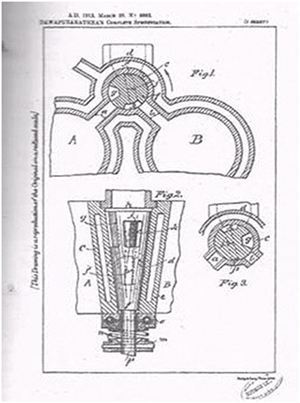Teenage Royalist granted a British royal patent 100 years ago

Dawapurarathna in 1912
Bertram Elibank Dawapurarathna was the inventor of a mechanism that improved the Reversing Gear in Steam engines. His original design was patented and registered in London in 1910 (patent no. 6883). He also had a second patent in 1913 for a device that improved the valve mechanism of internal combustion Engines.
After completing his studies at Royal College, he went to England to pursue higher studies in Mechanical Engineering at the University of Glasgow in 1912. He chose the University of Glasgow as this was where the famous mechanical engineer James Watt developed improvements to the steam engine, after whom the unit of power “Watt” was developed. Professor William Rankine who developed the complete theory of the steam engine and the “Rankine Cycle” also attended the University. Glasgow was also the home of the North British Locomotive Co, which was the largest locomotive manufacturer in Europe, and supplied many of the locomotives to the Ceylon Government Railway (CGR).
On March 20, 1913, a few months after Bertram commenced his engineering studies in Glasgow, he applied for a patent for “Improved Valve Mechanism for Internal Combustion Engines”. He was granted Royal Patent No. 6883 exactly a year later on March 20, 1914.

Patent design
The most commonly used valves in four stroked internal combustion engines are poppet valves. The minimum number of valves is two per cylinder (inlet & exhaust). Some high performance engines have more than the minimum number. Dawapurarathna’ s patent was a proposal to reduce the number of valves from four to two, for two cylinders. The two cylinder “A” and “B” have a common valve chamber “c” in which there is a rotating tapered plug valve “f” rotating at half the crankshaft speed. The air/fuel mixture from the carburetor enters from the top through the passage “h” and is admitted to the cylinders when the gap “g” is in line with the ports “a” and “b”. Line up with the gap “k”, the exhaust gases leave the cylinder through the passage “j” to the exhaust outlet “d”. This was quite an ingenious idea to reduce the number of valves and cost of the engines.
It is said that during the war he was flying a test plane which crashed. He was hospitalized, seriously injured. His Doctors thought that he stood a better chance of recovery if he were to return to Colombo to convalesce in a warm climate. He had by then graduated as a mechanical engineer. In 1917 he had embarked on a ship ‘ P & O Nyanza’ to return to Ceylon. On the way the ship had been attacked by a German submarine and badly damaged within 25 miles off the shores of England. Both Bertram Dawapurarathna and another Ceylonese passenger on the ship – Walter de Silva, were seriously injured and both died in hospital after they were taken back to England in the badly damaged ship.
Available records reveal that Bertram Dawapurarathna had died in 1918, when he was 22 years old, and his ashes were interred in a British cemetery.


